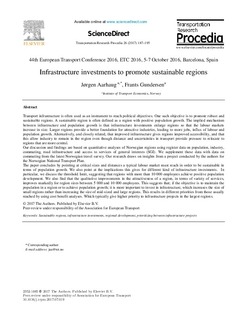| dc.contributor.author | Aarhaug, Jørgen | |
| dc.contributor.author | Gundersen, Frants Henrik | |
| dc.coverage.spatial | Norway | nb_NO |
| dc.date.accessioned | 2019-06-27T07:07:11Z | |
| dc.date.available | 2019-06-27T07:07:11Z | |
| dc.date.created | 2017-09-19T10:27:22Z | |
| dc.date.issued | 2017-08-14 | |
| dc.identifier.citation | Transportation Research Procedia. 2017, 26 187-195. | nb_NO |
| dc.identifier.issn | 2352-1465 | |
| dc.identifier.uri | http://hdl.handle.net/11250/2602436 | |
| dc.description.abstract | Transport infrastructure is often used as an instrument to reach political objectives. One such objective is to promote robust and sustainable regions. A sustainable region is often defined as a region with positive population growth. The implied mechanism between infrastructure and population growth is that infrastructure investments enlarge regions so that the labour markets increase in size. Larger regions provide a better foundation for attractive industries, leading to more jobs, influx of labour and population growth. Alternatively, and closely related, that improved infrastructure gives regions improved accessibility, and that this allow industry to remain in the region even though distance and uncertainties in transport provide pressure to relocate to regions that are more central.
Our discussion and findings are based on quantitative analyses of Norwegian regions using register data on population, industry, commuting, road infrastructure and access to services of general interests (SGI). We supplement these data with data on commuting from the latest Norwegian travel survey. Our research draws on insights from a project conducted by the authors for the Norwegian National Transport Plan.
The paper concludes by pointing at critical sizes and distances a typical labour market must reach in order to be sustainable in terms of population growth. We also point at the implications this gives for different kind of infrastructure investments. In particular, we discuss the threshold limit, suggesting that regions with more than 10 000 employees achieve positive population development. We also find that the qualitative improvements in the attractiveness of a region, in terms of variety of services, improves markedly for region sizes between 5 000 and 10 000 employees. This suggests that; if the objective is to maintain the population in a region or to achieve population growth; it is more important to invest in infrastructure, which increases the size of small regions rather than increasing the size of mid-sized and large regions. This results in different priorities from those usually reached by using cost benefit analyses. Which typically give higher priority to infrastructure projects in the largest regions. | nb_NO |
| dc.language.iso | eng | nb_NO |
| dc.publisher | Elsevier | nb_NO |
| dc.rights | Attribution-NonCommercial-NoDerivatives 4.0 Internasjonal | * |
| dc.rights.uri | http://creativecommons.org/licenses/by-nc-nd/4.0/deed.no | * |
| dc.title | Infrastructure investments to promote sustainable regions | nb_NO |
| dc.title.alternative | Infrastructure investments to promote sustainable regions | nb_NO |
| dc.type | Journal article | nb_NO |
| dc.type | Peer reviewed | nb_NO |
| dc.rights.holder | © 2017 The Authors. Published by Elsevier B.V | nb_NO |
| dc.description.version | publishedVersion | nb_NO |
| cristin.unitcode | 7482,1,3,0 | |
| cristin.unitname | Regional utvikling og reiseliv | |
| cristin.ispublished | true | |
| cristin.fulltext | original | |
| cristin.qualitycode | 1 | |
| dc.identifier.doi | 10.1016/j.trpro.2017.07.019 | |
| dc.identifier.cristin | 1495217 | |
| dc.source.journal | Transportation Research Procedia | nb_NO |
| dc.source.volume | 26 | nb_NO |
| dc.source.pagenumber | 187-195 | nb_NO |

